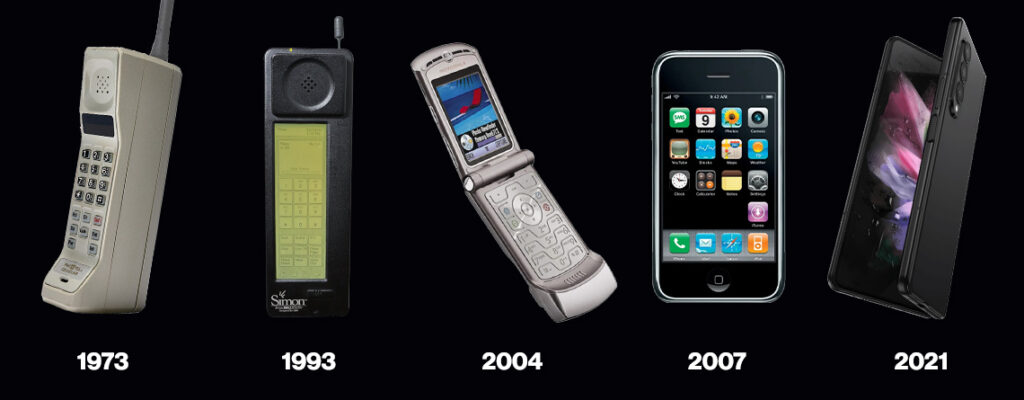Have you ever wondered when the first smartphone was invented? It’s hard to imagine life without these pocket-sized devices that keep us connected, informed, and entertained.
But there was a time when smartphones didn’t exist. Understanding their origin not only feeds your curiosity but also deepens your appreciation for the technology you rely on every day. You’ll discover the fascinating timeline of the smartphone’s invention, revealing surprising facts and milestones that shaped the tech world as you know it.
Get ready to unravel the story behind the gadget that’s become an essential part of your life.
-min.jpeg)
Credit: www.textedly.com
Early Concepts Of Mobile Communication
Smartphones have become essential in modern life. But their journey began long ago. Early concepts of mobile communication laid the foundation. These ideas sparked the innovation we see today. Let’s explore how the vision for mobile communication evolved.
Early Radio Phones
Early radio phones were bulky and limited. They used radio waves to transmit signals. In the 1940s, engineers developed these devices for military use. They allowed soldiers to communicate over long distances. This technology was a key step towards mobile phones.
The First Mobile Call
The first mobile call was a landmark event. On April 3, 1973, Martin Cooper made history. He called from a handheld device in New York City. This event marked the beginning of personal mobile communication. It showed the world that wireless calls were possible.
Bell Labs’ Innovations
Bell Labs played a vital role in mobile communication. In the 1940s, they developed the first cellular network concept. This concept divided areas into cells with towers. Each cell could handle many calls. This idea became the backbone of modern mobile networks.
The Rise Of Car Phones
Car phones emerged in the 1980s. They were large and often installed in vehicles. These phones allowed people to make calls while traveling. Despite their size, they were a step towards portable communication. They paved the way for more compact devices.
Transition To Handheld Devices
The 1980s and 1990s saw a shift to handheld devices. Companies focused on making phones smaller and more user-friendly. These efforts led to the creation of the first true mobile phones. This shift was crucial in the journey towards modern smartphones.
The First Mobile Phone
The invention of the mobile phone marked a new era in communication. It changed how people connected, making calls on the go possible. The first mobile phone was not like the sleek devices we use today. It was much larger and had limited functionality. Yet, it laid the foundation for the smartphones we use now.
Understanding the history of mobile phones helps appreciate the technology we have. The journey began with a remarkable innovation by Martin Cooper. This breakthrough led to the creation of the first mobile phone.
Martin Cooper’s Innovation
Martin Cooper was a visionary in the field of communication. He worked for Motorola and had a bold idea. Cooper wanted a phone that could be used anywhere. In 1973, he made the first mobile call. He used a large prototype, which was not yet available to the public. This call was a significant moment in history. It demonstrated the potential of mobile communication.
Cooper’s innovation was a turning point. He showed the world that mobile communication was possible. His work inspired further developments in mobile technology.
The Motorola Dynatac
The Motorola DynaTAC was the first commercially available mobile phone. Released in 1984, it was a groundbreaking product. The phone was large, weighing about two pounds. It had a long antenna and limited battery life. Despite its size, people were excited about the new technology.
The DynaTAC made mobile communication accessible to the public. It paved the way for future advancements in mobile phones. This device was the first step towards the smartphones we use today.
From Mobile Phone To Smartphone
The journey from mobile phones to smartphones is a fascinating tale of technological evolution. Remember the days when mobile phones were merely devices for calling and texting? Today, they are indispensable tools that connect us to the digital universe. But how did we get here, and what makes a smartphone truly smart?
Defining The Smartphone
The term “smartphone” signifies a leap beyond basic mobile phones. A smartphone is essentially a mini-computer in your pocket. It integrates a phone’s basic functionalities with advanced computing capabilities. Think of the first time you watched a video on your phone or used a mobile app. That was your first taste of what smartphones could do.
Smartphones run on sophisticated operating systems like Android or iOS. These systems allow you to install apps, browse the internet, and even conduct video calls. You may recall your excitement when you first downloaded an app, realizing the myriad possibilities at your fingertips.
Key Features That Set Smartphones Apart
What differentiates smartphones from traditional mobile phones? Let’s consider some key features:
- Touchscreen Interface:Smartphones sport large touchscreens that make navigation intuitive. Remember the clunky buttons of old mobile phones? Those days are long gone.
- Connectivity:With Wi-Fi and mobile data, smartphones keep you connected to the world. You can check emails, surf social media, or even work remotely. How often do you rely on your phone’s internet for urgent tasks?
- App Ecosystem:A vast array of apps cater to every need—whether it’s gaming, productivity, or socializing. Think of your favorite app. How has it made your life easier?
- Camera Capabilities:Smartphones boast high-quality cameras that rival dedicated digital cameras. Have you ever captured a stunning sunset or a memorable family moment on your phone?
These features have transformed our daily lives, making smartphones indispensable. But as you use yours, ask yourself: What do you think the future holds for smartphone technology? How can it further enrich your life?

Credit: www.weforum.org
Ibm Simon: The First Smartphone
IBM Simon, released in 1994, marked the birth of the smartphone era. This pioneering device combined phone and PDA functions. It laid the foundation for future mobile technology advancements.
In the world of technology, few inventions have had as profound an impact as the smartphone. It’s hard to imagine a day without checking your phone, right? But have you ever wondered where this indispensable device began? Let’s travel back to 1994 and meet the IBM Simon, the trailblazer in the smartphone revolution.Introduction Of Ibm Simon
IBM Simon was introduced to the world as a game-changer. Picture this: a device that was not just a phone but also offered PDA-like functionalities. At the time, it was a revelation. You could send emails, keep a calendar, and even make calls—all from one device. It was like carrying a mini office in your pocket. Although it was bulky and expensive, the IBM Simon laid the foundation for the smartphones we use today.Features And Capabilities
The IBM Simon had a monochrome touchscreen, a feature that was cutting-edge at the time. Imagine the surprise of using a stylus to navigate your phone. It offered an address book, a calculator, and a world clock, making it versatile for everyday use. It even supported fax and email capabilities, which was revolutionary for a mobile device back then. Have you ever thought about how you would have managed your daily tasks without today’s smartphones? The IBM Simon started that conversation by showing us what was possible. It was a peek into the future and sparked imaginations worldwide. The question is, how did people react to such a novel idea in 1994? Did they realize they were witnessing the dawn of an era? As you ponder this, remember that every swipe and tap today traces back to this pioneering device. So, next time you unlock your phone, take a moment to appreciate the journey from IBM Simon to the sleek smartphones of today. How far we’ve come, and who knows what the future holds?The Evolution Of Smartphone Technology
The smartphone has transformed our lives in countless ways. Its evolution is a story of innovation and adaptation. Over the years, smartphones have become more advanced, yet user-friendly. They blend technology with everyday needs, offering more than just communication.
Understanding their journey helps us appreciate these pocket-sized wonders. Let’s explore how smartphones evolved over time.
Rise Of Touchscreen Interfaces
Early phones had physical buttons. They were bulky and complex. The introduction of touchscreens changed everything. Touchscreens made interaction simple and intuitive. No more tiny keys or styluses. Just a swipe or tap to navigate. This shift made phones more accessible to everyone.
Touchscreen technology has improved rapidly. Screens became more responsive and durable. They offer vibrant colors and clear images. This innovation set the stage for modern smartphones.
The Role Of Mobile Operating Systems
Operating systems are the backbone of smartphones. They manage hardware and software operations. Early mobile operating systems were basic. They lacked advanced features. As technology advanced, so did these systems.
iOS and Android are popular today. They offer seamless user experiences. These systems support thousands of apps, from games to productivity tools. Users can customize their phones to fit their needs. Security features also improved, keeping data safe.
The evolution of mobile operating systems is ongoing. Each update brings new capabilities and improved performance.
Impact Of Smartphones On Society
Smartphones began changing society with their invention in 1992. These devices have since impacted communication and daily life significantly. They offer instant access to information, transforming how people connect and interact globally.
The invention of the smartphone has undeniably transformed society in ways we never imagined. These pocket-sized devices have altered how you interact with others, how you manage your day, and even how you think. Imagine the world before smartphones—it seems a distant memory now. But what has this technological marvel truly done to our society? Let’s dive into the profound impacts of smartphones.Communication Revolution
Smartphones have sparked a communication revolution. You can connect with anyone, anywhere, instantly. Gone are the days of waiting by the landline or sending letters. Think about how your day starts—checking messages, emails, and social media. It’s hard to believe this was once impossible. This instant connectivity has made the world smaller, allowing you to build relationships across continents. Are you using this connectivity wisely?Smartphones And Daily Life
Smartphones have woven themselves into the fabric of your daily life. They are your calendar, camera, and entertainment hub. Remember the last time you left home without your phone? It probably felt like you were missing a limb. They help you organize tasks, track fitness goals, and even order groceries. But, do they also distract you from real-world interactions? Balancing smartphone use is key to maintaining a healthy lifestyle. How do you ensure your phone is a tool, not a distraction? Smartphones have changed your world. Their impact continues to evolve, offering new possibilities and challenges. How will you adapt to these changes?Future Of Smartphone Technology
The future of smartphone technology holds exciting possibilities. Smartphones have evolved rapidly. They are no longer just communication devices. They are integral to daily life. As technology advances, smartphones continue to adapt. New features and capabilities emerge. These changes promise to redefine how we interact with the world.
Emerging Innovations
Smartphones now integrate artificial intelligence. AI enhances user experience. Voice recognition improves daily tasks. Personalized recommendations simplify choices. Augmented reality transforms how we see things. It blends digital elements with the real world. Foldable phones offer flexibility. They provide larger screens when needed. This innovation changes device design.
Battery technology is advancing. Longer battery life means more convenience. Quick charging reduces downtime. Biometric security strengthens privacy. Fingerprint and facial recognition offer secure access. Wireless charging eliminates cables. Future smartphones might charge through the air. Internet of Things (IoT) connectivity broadens device capabilities. Smartphones can control smart homes and cars.
Predictions For Future Developments
Smartphones will become even smarter. They might predict user needs. Enhanced AI will drive this change. Cameras will improve further. High-definition photos will be the norm. New sensors will offer more features. Smartphones might track health metrics. They could monitor heart rates and stress levels.
5G connectivity will expand. Faster internet speeds will enhance streaming. Virtual reality might become common. Wearable technology will integrate with smartphones. Devices will become more personalized. Customization will cater to individual preferences. Sustainability will guide future designs. Eco-friendly materials will be favored. Energy-efficient processes will reduce waste.

Credit: www.cellularsales.com
Frequently Asked Questions
When Was The First Smartphone Invented?
The first smartphone was invented in 1992 by IBM and was called Simon Personal Communicator. It combined features of a mobile phone and a PDA. Released in 1994, it included a touch screen and could send emails and faxes. It was a groundbreaking innovation in mobile technology.
Who Invented The First Smartphone?
The first smartphone was invented by IBM. Simon Personal Communicator, created by IBM, was the world’s first smartphone. It was designed by Frank J. Canova and released in 1994. This device set the foundation for future smartphone developments by integrating communication and computing functions.
What Was The Name Of The First Smartphone?
The first smartphone was called Simon Personal Communicator. Released by IBM in 1994, Simon combined mobile phone capabilities with PDA functions. It featured a touch screen and could send emails and faxes. Simon was a revolutionary device for its time, setting the stage for modern smartphones.
Why Was The First Smartphone Significant?
The first smartphone, Simon, was significant for merging communication and computing. Released in 1994, it introduced features like a touch screen and email capabilities. Simon paved the way for future smartphones by integrating various technologies, revolutionizing the way people communicate and access information on-the-go.
Conclusion
The smartphone has changed the way we live and communicate. Its journey began in the early 1990s. Since then, it has evolved rapidly. From simple calls to smart apps. Smartphones are now essential tools. They help us stay connected. They assist in daily tasks.
But they also raise questions. About privacy and screen time. They continue to shape the future. As technology advances, smartphones will adapt. They will meet new needs. Their impact on society is significant. The smartphone’s invention is a key milestone.
It has transformed our world forever.





